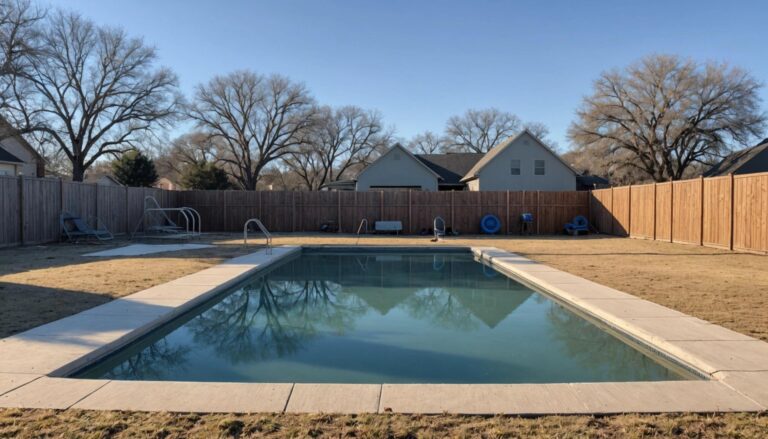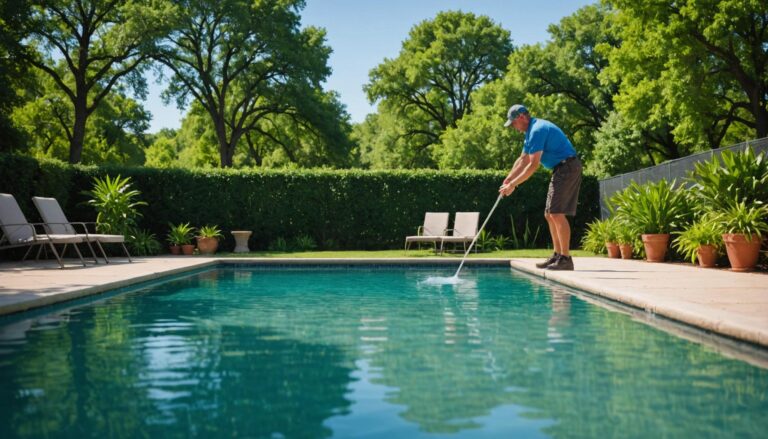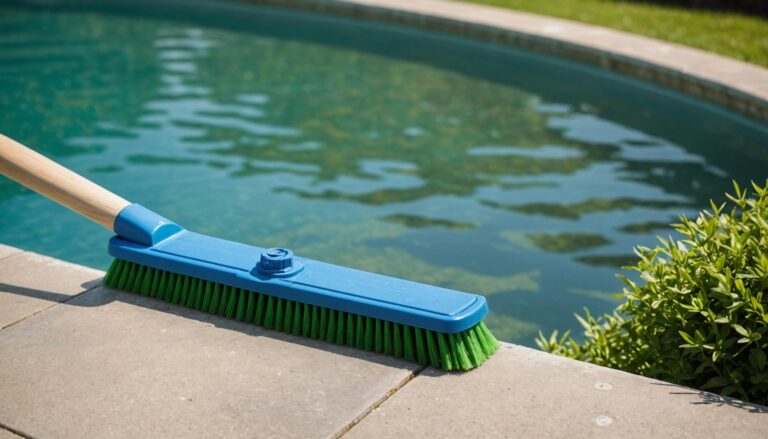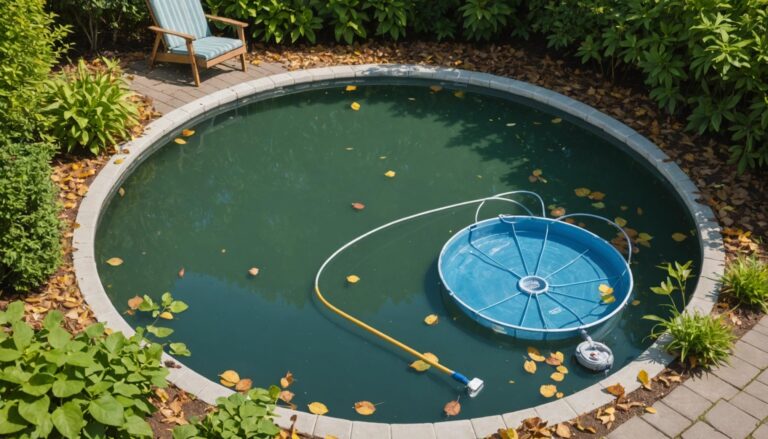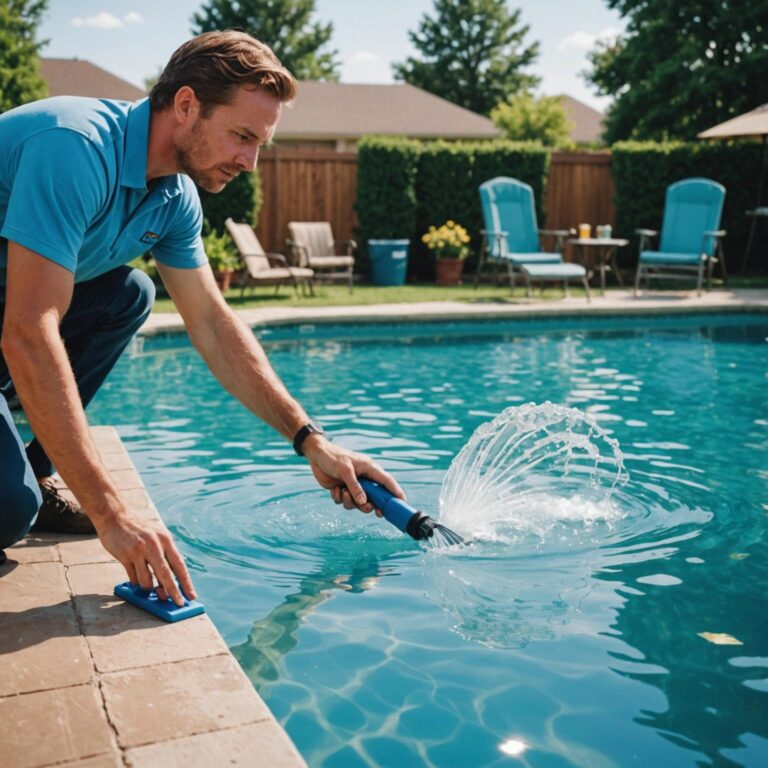How Often Should You Clean Your Pool in the Texas Summer Heat? (Expert Tips)
Are you wondering how often you should clean your pool in the Texas summer heat? At Blue Shade Pools, we understand the sweltering summer months in Texas can wreak havoc on your backyard oasis. Our goal is to ensure that your pool remains sparkling clean and inviting, even when temperatures rise above 100°F.
In this article, we’ll dive into the importance of pool maintenance during these hot months, provide key insights on testing your pool water, and outline essential cleaning tasks to keep your pool in tip-top shape. Whether you’re in Fort Worth or any of the surrounding areas, we’re here to share expert tips to maintain your pool’s pristine condition all summer long. Dive in with us and discover how to overcome the challenges of pool upkeep in the intense Texas heat!
Why is Pool Maintenance Especially Important in Texas Summers?
Texas summers are notorious for their scorching heat and intense sunlight, making pool maintenance particularly crucial. The high temperatures and strong UV rays can accelerate the growth of algae and bacteria in your pool, making the water less inviting and potentially unsafe. Regular maintenance ensures that your pool remains clean, clear, and chemically balanced, providing a safe haven from the relentless Texas heat.
Higher Temperatures Accelerate Chemical Imbalance
When temperatures rise, the chemicals in your pool—specifically chlorine—can break down faster. This can lead to algae growth and murky water if not managed properly. More frequent testing and adjustment of chemical levels are necessary to keep your pool inviting and safe to swim in.
Increased Usage During the Hot Months
During a Texas summer, your pool likely sees increased usage as everyone looks to cool down. More swimmers and water activities can introduce contaminants like sunscreen, sweat, and oils that can disrupt your pool’s chemical balance. Regular cleaning and monitoring become essential to combat these effects. For comprehensive guidance, consider expert weekly pool cleaning services that cater to the unique challenges of Texas summers.
Evaporation Concerns
The extreme heat speeds up water evaporation, which can lower water levels and alter chemical concentrations. Keeping a close eye on your pool’s water level and refilling it as needed is vital during these months to maintain the balance necessary for safe swimming conditions.
In essence, diligent pool maintenance in the summer not only enhances your enjoyment but also ensures the health and safety of all swimmers. Up next, we’ll dive deeper into how frequently you should test your pool water in the blazing Texas sun.
How Frequently Should You Test Pool Water in Hot Weather?
In the sweltering Texas summer heat, maintaining pool water quality is crucial. High temperatures and increased use can affect water balance and chemical levels. Regular testing ensures that your pool stays clean, safe, and inviting.
Here’s how often you should test your pool water during hot weather:
- Daily: Check chlorine and pH levels daily—especially after heavy usage or rain—to ensure optimum sanitation and comfort.
- Twice a Week: Test for alkalinity and calcium hardness. These tests help maintain water balance and protect pool surfaces.
- Weekly: Test for stabilizer (cyanuric acid) and total dissolved solids (TDS). High levels can make chlorine less effective and create maintenance challenges. For more detailed guidance, consider regular weekly pool cleaning services in Southlake, TX.
- Monthly: Conduct a comprehensive test to include metals like copper and iron, which can cause staining or discoloration if left unchecked.
- As Needed: Test immediately after significant environmental changes, such as a heatwave, storm, or after adding new water, to keep levels in check.
Regular testing and prompt adjustments help keep your pool healthy and ready for a refreshing dip, even during the hottest days.
What are the Essential Cleaning Tasks for a Texas Pool?
Keeping a pool clean in the Texas summer heat requires a dedicated plan. The hot weather accelerates algae growth and can make your pool the perfect spot for bacteria. Regular cleaning is VITAL to enjoy crystal-clear water and ensure swimming safety.
Here’s a list of essential tasks every pool owner in Texas should prioritize:
- Skimming and Brushing: Skim the surface daily to remove leaves, bugs, and debris. Brush the sides and bottom of the pool weekly to prevent algae buildup.
- Vacuuming: Perform manual or robotic vacuuming at least once a week to capture grime and sediments that your skimmer misses.
- Cleaning Filters: Rinse or clean pool filters regularly—every two weeks or more, depending on usage—to maintain water clarity and circulation efficiency.
- Checking Water Levels: Check and adjust water levels weekly; too low affects the pump, and too high reduces efficiency of skimmers.
- Testing and Adjusting Chemicals: Test water chemistry 2-3 times a week—especially chlorine and pH levels—and adjust accordingly to ensure safe and balanced water.
- Shock Treatments: Shock the pool weekly, or after heavy use or rainfall, to eliminate bacteria and keep the water sanitized.
- Tile and Deck Cleaning: Clean pool tiles and decking monthly to remove calcium and mineral deposits for both aesthetics and functionality.
Consistent maintenance keeps your pool inviting and trouble-free, allowing you to beat the Texas heat with confidence. For more detailed guidance, consider exploring weekly pool cleaning strategies that are particularly effective in North Richland Hills, TX. Next, let’s look at how often you should check your pool equipment during these hot months.
How Often Should You Check Pool Equipment During the Summer?
Maintaining your pool equipment is CRUCIAL for keeping your pool running smoothly and efficiently, especially during the hot Texas summers. Intense heat and frequent use can place extra stress on your pump, filter, and other components. So, how often should you actually check your pool equipment to ensure it remains in top-notch condition? Let’s break it down.
Weekly Checks
At a minimum, inspect your pool equipment weekly. This includes checking the pump for any unusual noises or leaks and ensuring the pool filter is clean and functioning properly. A dirty filter can diminish water flow and increase strain on the pump, so cleaning or replacing filters regularly helps avoid costly repairs.
Biweekly Monitoring
Beyond your weekly checks, you should perform a more detailed inspection every two weeks. This involves checking the pool’s chlorinator or chemical feeders, ensuring they’re dispensing the right amount of chemicals. Also, examine plumbing connections for any signs of wear or leaks, as well as electrical components for any corrosion or damage.
Monthly Deep Dive
Once a month, take a deeper dive. Open the pump and skimmer baskets to clear out any debris. This improves circulation and efficiency. Lubricate pump O-rings if necessary to keep them in good working order. Additionally, review the pool’s water levels—especially during periods of high evaporation—to ensure the pump isn’t running dry. For more insights on maintaining your pool during the summer, you can explore cleaning your pool in the Texas summer.
Keeping a regular schedule for checking pool equipment helps avoid potential breakdowns and maintains the longevity of your pool system. Next, we’ll explore common pool problems during Texas heatwaves and how you can address them.
What are Common Pool Problems During Texas Heatwaves?
Texas heatwaves can turn pool ownership into a challenging affair. The extreme heat not only makes your pool a prime spot for relief but also introduces several issues that can affect water quality and equipment. Here’s a rundown of common pool problems during those scorching Texan days.
Frequent Pool Issues:
- Algae Growth: Warm temperatures fuel rapid algae growth, making pool surfaces slippery and water cloudy.
- Evaporation: High heat increases water evaporation, leading to decreased water levels and potential imbalance in pool chemicals.
- Imbalanced pH Levels: Heat can cause fluctuations in pH and chlorine levels, making it harder to maintain proper water chemistry.
- Increased Debris: Heatwaves often come with dry, windy conditions that blow more debris into pools, clogging filters and skimmers.
- Equipment Strain: Constant high temperatures put extra stress on pool equipment, leading to potential breakdowns or reduced efficiency.
- Scale Formation: Heat accelerates the formation of scale on pool surfaces and equipment, complicating maintenance efforts.
Staying proactive with regular testing and maintenance can help you mitigate these common problems and keep your pool inviting all summer long. For more detailed guidance, explore these Texas pool maintenance tips. Next, we’ll discuss strategies for checking pool equipment to prevent issues before they start.
What Expert Tips Help Keep Pools Clean in Intense Heat?
Keeping a pool clean during the Texas summer heat can be a challenge. The combination of high temperatures, increased usage, and sunny days can lead to quick water quality changes and algae blooms. Here’s how to stay ahead:
Regular Skimming and Monitoring
Skimming your pool daily helps keep leaves, debris, and bugs from settling at the bottom. Frequent monitoring of water chemistry—ensuring pH, chlorine, and alkalinity levels are balanced—is essential for clean water and safe swimming.
Optimize Filtration System
Maximize your pool’s filtration system during the hot summer months. Run the filter longer than usual—at least 8-12 hours a day—to ensure more contaminants are removed efficiently.
Shock the Pool Weekly
Algae can quickly take hold during high heat. By “shocking” your pool with extra chlorine once a week, you’ll get rid of any persistent bacteria or algae spores that regular chlorination might miss. For a more detailed guide on maintaining your pool in Texas conditions, check out this comprehensive pool cleaning guide.
Use Algaecides and Clarifiers
Adding algaecides can help control blooms before they overpower your pool. Clarifiers coagulate small particles, making it easier for your filter to capture them—keeping your water crystal clear.
Keep an Eye on Water Levels
Hot weather leads to evaporation or splashing that can lower your pool’s water level. Make sure to regularly top it up to maintain proper skimmer and pump operation, which is vital for effective filtration.
By applying these expert tips, you can maintain a clean and healthy pool all summer long, even when the Texas heat is at its peak. Up next, we’ll explore the importance of monitoring and maintaining pool equipment during sweltering summers.
Conclusion
Ensuring your pool is clean and well-maintained during the intense Texas summer heat is essential for a safe and enjoyable swimming experience. Regular pool cleaning not only helps in maintaining water clarity but also prevents the growth of algae and bacteria, which can thrive in warmer conditions. Adopting a consistent cleaning routine—preferably on a weekly basis—can ensure that your pool remains in optimal condition throughout the summer.
At Blue Shade Pools, we understand the unique challenges posed by the Texas summer and are here to support you with top-tier pool cleaning services. Our expert team is dedicated to providing reliable and effective services tailored to your needs, whether you reside in Fort Worth, Southlake, or any of the other areas we serve. Let us handle the hard work while you focus on enjoying your pool. Contact Joao Contessoto and the team at Blue Shade Pools today at 817-770-9524 or email us at info@blueshadepools.com to schedule your pool cleaning and maintenance. Enjoy a worry-free summer with a sparkling clean pool!



